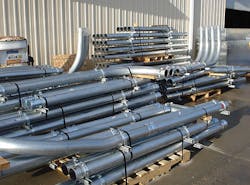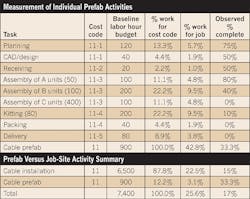Is Prefabrication Making You Money?
Like many other industries, construction is going through constant change to keep up with market demands. Industrialization and globalization of the construction design, procurement, and build process has forced more and more contractors to adopt prefabrication and vendor-managed inventory processes and programs.
The challenge facing contractors and project managers, as well as field personnel, is adopting an appropriate method of measurement of progress and performance of the prefab activities. Selecting a correct method of measurement for prefabrication performance allows contractors and project managers to establish the impact of these activities on their profitability and future project pricing. The measurement can be cost-based or hours-based. Either method will produce the desired results of knowing how much prefab is done and how well it is being done. In this article, however, we will focus on hours-based measurement.
Measuring progress
Prefabrication tasks are activities that can be productively transferred away from the installation site or even away from the job site entirely. One issue associated with transferring work away from a job site is how to measure the progress of work in the prefabrication process as related to overall job progress.
Every construction installation task may be viewed as having three separate phases:
1) Prepare: transportation/distribution of labor, tools, materials, and plans to the job site; preparation of the labor (understanding the plans and schedule), tools (setting and powering up), and material (receiving, unpacking, fabrication, assembly, etc.); and movement of materials to the final installation site.
2) Install: the actual installation task
3) Put away: return workers, tools, and leftover material to location(s) appropriate for the next task.
Often, these three activities are tough to distinguish because they are all seen as “part of the work,” but unless they are at least understood separately, the work cannot be segregated and measured. Prefabrication tasks still consist of the same three general phases (i.e., replacing “install” with “make,” “prep,” or “assemble.”
Advantages of a prefab work area include:
• Savings from reduced cost and effort (i.e., labor hours) associated with: less material handling, fewer material returns, less wasted material, improved labor efficiency, and improved labor productivity
• Consistency of production
• Increased reliability
• Improved safety
• Manpower flexibility or buffer
• Decoupling of sequence of work from sequence of time on the project.
The current question is how to measure the progress of prefabrication activities with an appropriate metric. We’ll do so with a metric based on ASTM Standard E2691 for measuring construction productivity. Assume for now that an allotment of hours from the job has been identified for prefabrication activities. This “budget” will exist for baseline tracking of completion within the overall job.
Employing a JPAC system
The prefabrication itself will be tracked as a separate prefab project in a job productivity assurance and control (JPAC®) system with only the progress (percent complete) needing to be transferred. Because the tasks in a JPAC are ideally established according to the way the work is done, the prefab tasks may need to use different cost codes than the labor codes for the purpose of tracking productivity in prefab. For example, work such as planning, design/CAD, materials (ordering, receiving, etc.), assembly, kitting/packaging, and delivery can be translated to task items in corresponding labor cost codes and transferred directly, as shown in the Table.
While it could be daunting to individually break down the fabrication hours out of every job task, certain patterns exist that will simplify the process, as most tasks will follow one of three basic forms.
1) Common across all jobs — standard materials, always on hand, occur on almost every job site. They include: boxes, wall mounts, MC whips, and fixture kits. The assembly effort is predictable (by unit) and correlates with quantity produced; standard assembly units could be developed for these units, mapping to the cost codes automatically.
2) Common within job categories — assemblies and applications specific to a type of work (e.g., schools, hospitals, airports, hotels, water treatment plants, etc.). These include: racks, plumbing fixture carriers, high-bay light assemblies, and hospital headwalls. This work includes a one-time arrangement for basic planning/setup/layout within the job, then ongoing production. In other words, a work breakdown template can be developed that can be replicated for tracking after the assembly is produced once.
3) Job specific — one-of-a-kind or high-risk elements of a project. These include items like specialty lighting or décor, underground utilities, and material handling equipment. These tasks can be tracked with a specific work breakdown template of all elements involved.
For tasks that encompass more than one labor code, the effort can be allocated to the appropriate multiple job cost codes through an “automatic unbundling” when translating to the job. For example, “Assembly of B-units” in the Table might be 40% cable, 60% wire, and the percent completion to the job codes would be distributed accordingly.
Prefabrication as a means of segregation of work is here to stay. The risk of a typical construction environment can be reduced drastically by doing a majority of the work in a controlled environment. However, contractors must be able to measure the work that is not being done in a traditional manner. Based on the pointers above, as long as the work being done away from the job site is tracked appropriately as a contributor to construction put in place, the contractor will be on the right track.
Daneshgari is president and CEO of MCA, Inc., Grand Blanc, Mich. Moore is vice president of operations. Clark is director of operations. They can be reached at [email protected], [email protected], and [email protected].
About the Author
Dr. Heather Moore
Vice President of Operations
Dr. Heather Moore is VP for customer care and support at MCA, Inc., as well as a well-known researcher and author in the construction industry. Dr. Heather can be reached at [email protected]. She is also part-owner of a WBENC-certified company, WEM, LLC, that provides logistics and scheduling services for the construction industry, as well as being the only licensed reseller of MCA, Inc.’s software products that are focused on Making Productivity Visible to Everyone®.


